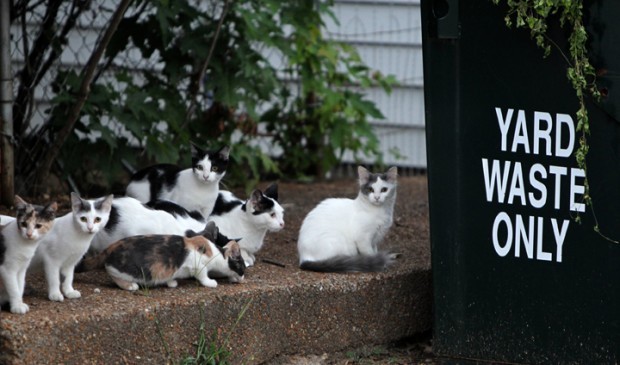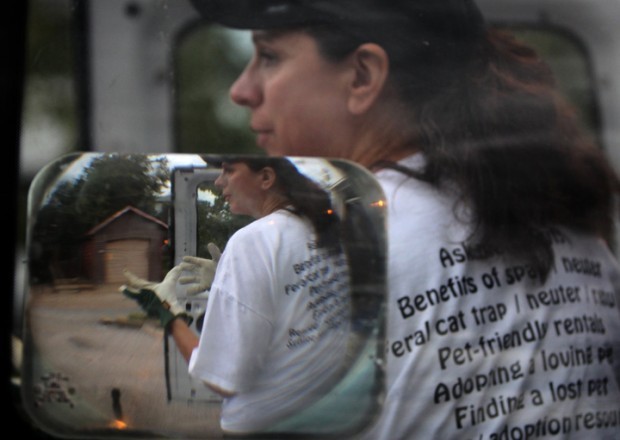ST. LOUIS • The alley was empty as the sun rose. Then a little white sedan pulled in from a neighborhood street.
And with the sound of that familiar engine came the cats. They poured out of holes in garage doors, slipped under fences and bounded out of bushes, loping after the car. When the driver got out, the cats encircled her. There were at least a dozen. They expected breakfast.
But there would be no fancy feast this morning. The driver - and cats' daily feeder - was helping a volunteer set out wire cages.
In the past, such an operation would lead to the city pound and death by injection. Now, many cities and animal control agencies are giving up old catch-and-kill methods, and relying instead on a unique and relatively unknown society of animal lovers to deal with a mostly hidden problem.
This winter, Ó£ÌÒÊÓƵ's health director plans to ask city leaders for $20,000 to support, for the first time, a volunteer organization that traps homeless cats, neuters or spays them and then returns them to the neighborhoods in which they live.
People are also reading…
The Ó£ÌÒÊÓƵ region, like most big cities, has tens of thousands of stray cats roaming freely, often largely unnoticed. In the suburbs, they live in forests and backyards. In the cities, they live in abandoned homes, vacant buildings and alleyway garages.
No one knows how many are here. They are lanky and skittish, forage for garbage at night, hunt mice and rats. They are often fed by neighbors, who think the cats would go hungry if they stopped. And these felines procreate, sometimes prodigiously.
Animal coalitions say female cats may well birth two litters of four or five kittens annually. An alleyway colony, as they're called, can grow from 10 to 50 in a year.
And as colonies grow, so do neighborhood complaints, and animal control often traps the felines. Feral cats, however, will bite and scratch anyone who picks them up and can rarely be rehabilitated. Shelters kill thousands a year.
But that alone hasn't succeeded in controlling the cat population, say animal advocates. Cats left on the streets just keep making kittens, and new cats move into the old ones' places.
Then, about 10 years ago, a few animal lovers here started doing something different.
They began trapping cats themselves.
They bought their own cages, loaded the cats into their vans, and, at least at first, paid with their own money to sterilize and vaccinate them. After the cats had recovered, the volunteers would return them to the place they were found, minus the top tip of each left ear - to mark them as fixed.
Trap-neuter-return
Ó£ÌÒÊÓƵ is not the first city where local Samaritans do such work, called trap-neuter-return. Volunteers have been trapping cats in Chicago, Baltimore and Washington for years. The national feral cat advocacy group Alley Cat Allies estimates there are 250 nonprofits trapping, and new ones starting all the time.
But Ó£ÌÒÊÓƵ is on the forefront of a less common trend: local government support for the programs.
St. Charles County began working with a local nonprofit on feral cat sterilizations seven years ago. The program, funded originally by donations and about $5,000 in grant funds, is now self-sufficient, and something of a success story. Cat intakes at the county shelter dipped to 900 last year from 1,500 in 2005. Kill rates dropped from 800 to half that.
Now Pam Walker, Ó£ÌÒÊÓƵ City's health director, is planning a similar program. She's already begun working with the volunteer trapper for St. Charles County, Val Schweickhardt, sending her city cat complaints, and paying about $3,000 for feral sterilization and vaccination.
Schweickhardt's nonprofit, Metro Animal Resource Services, has been quietly trapping cats in Ó£ÌÒÊÓƵ for a decade. It has helped manage hundreds of colonies from Bridgeton to Jefferson County to Illinois.
When one Rock Hill resident, for instance, realized he was feeding at least 30 cats in his backyard 10 years ago, he got directed to Schweickhardt. "I didn't eat breakfast, lunch and dinner, but they did," he said. "I was just overwhelmed." Metro trapped 33 in one day around his house, and about 70 in total.
This is her hobby
As in many regions across the country, managing a cat colony is illegal in Ó£ÌÒÊÓƵ County. Feral cats are a threat, said county animal control program manager Rebecca Smail. They attack people, defecate on private property and spread diseases such as ringworm, rabies and toxoplasmosis. Someone feeding a colony could be cited for owning too many animals or harboring a nuisance.
"That's a huge public health risk," Smail said. So the county shelter holds unadoptable cats for 48 hours before euthanizing them. In 2009, it took in more than 7,700 total animals, maybe half of which were cats, and killed nearly 4,300.
Ó£ÌÒÊÓƵ city has similar laws. But health director Walker says she sees little risk in releasing sterilized, vaccinated cats back into city neighborhoods.
Walker has support. The Humane Society of Missouri, American Veterinary Medical Association, and American Society for the Prevention of Cruelty to Animals all recognize managed feral cat colonies as a part of a solution.
Public health officials are mandated to address diseases, said the ASPCA's chief epidemiologist, Dr. Margaret Slater. "But that doesn't necessarily coordinate with the magnitude of the risk," she said. Illnesses like rabies, she said, just aren't very common.
In the meantime, regional governments across the country - from Manheim, Pa., and Woodbine, N.J., to Carthage, Mo. - are forming trap-neuter-return policies.
But, in the end, the task itself usually goes much as it did that morning last month, in the alleyway south of Oleatha Avenue, west of Kingshighway, deep in south Ó£ÌÒÊÓƵ.
Volunteer trapper Dawn Rowley pulled into a parking lot in her customized Ford Econoline. The cargo van was stripped inside of seats and carpeting, sprayed with rubberized paint and stuffed with 30 wire traps and covers.
"You know how people have hobbies? Boats and stuff?" asked Rowley, an airline pilot by profession. "This is my boat."
But before Rowley laid traps on this day, the neighborhood cat feeder said she was going to try to pick up a few, which she insisted were friendly, and, hopefully, adoptable.
As Rowley watched from the lot, the woman reached for one. But the cat wouldn't tolerate it. It latched on to the woman's arm, clawed its way over her shoulder and ran. Blood droplets bloomed from her hands and wrists.
"I'm surprised she tried that," Rowley said, wincing. "She's so worried. She wants them in good homes. But these cats don't want to be in homes. This is their home."
Rowley trapped all morning, returned the next day, and the next.
By week's end, 19 newly sterilized cats were back in the alley, eating Fancy Feast on top of garbage cans.
Ìý












